| 
Biodiversity, short for biological diversity,
is a term for the variety of life on Earth. It can refer
to the variety of genes in a species, the variety of species
in an ecosystem, and the variety of ecosystems in a landscape
or region. High biodiversity usually means better environmental
health.
|  Genetic
diversity helps a species adapt to changes in its
environment, and to evolve over time. Genetic
diversity helps a species adapt to changes in its
environment, and to evolve over time.
|

 The
biodiversity of dragonflies in Manitoba is not well known.
In 1999 a volunteer based project, the Manitoba Dragonfly
Survey (MDS), began to inventory this province’s dragonflies.
To date the MDS has gathered more than 3000 records of dragonfly
species, but much of the province, especially in the north,
has yet to be surveyed. (Click
here to visit the MDS website.) The
biodiversity of dragonflies in Manitoba is not well known.
In 1999 a volunteer based project, the Manitoba Dragonfly
Survey (MDS), began to inventory this province’s dragonflies.
To date the MDS has gathered more than 3000 records of dragonfly
species, but much of the province, especially in the north,
has yet to be surveyed. (Click
here to visit the MDS website.)
|
| 
There are more than 5500 species of dragonflies
and damselflies in the world. In Canada, 208 species have
been recorded. In Manitoba, thanks to the MDS, we know there
are at least 98 species: 26 species of damselflies and 72
species of true dragonflies. The known species in Manitoba
belong to nine different families: three families of damselflies
(Zygoptera) and six families of true dragonflies (Anisoptera).
(BL = body length) |

- Broad-winged Damselflies (Calopterygidae)
-
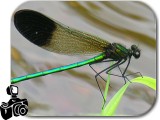 Large
damselflies (5 cm BL) with bright metallic-coloured bodies.
Likely only one (1) species in Manitoba, the River Jewelwing
(Calopteryx aequabilis). Jewelwings breed in swift running
streams and adults remain near the streams. Large
damselflies (5 cm BL) with bright metallic-coloured bodies.
Likely only one (1) species in Manitoba, the River Jewelwing
(Calopteryx aequabilis). Jewelwings breed in swift running
streams and adults remain near the streams.
|
- Spreadwing Damselflies (Lestidae)
-
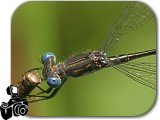 Medium
to large damselflies (3.5 - 5 cm BL) with dull-coloured
bodies. They leave their wings half-open at rest. There
are seven (7) species in Manitoba. Spreadwings breed in
small and temporary ponds. Medium
to large damselflies (3.5 - 5 cm BL) with dull-coloured
bodies. They leave their wings half-open at rest. There
are seven (7) species in Manitoba. Spreadwings breed in
small and temporary ponds.
|
- Pond Damsels (Coenagrionidae)
-
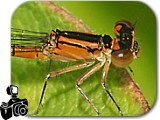 Small
to medium (2.3 – 4 cm BL), brightly coloured damselflies.
There are 17species in Manitoba. Pond damsels breed in
ponds and lakes. Small
to medium (2.3 – 4 cm BL), brightly coloured damselflies.
There are 17species in Manitoba. Pond damsels breed in
ponds and lakes.
|
|

- Darners (Aeshnidae)
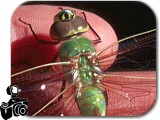 Large,
robust dragonflies (6 – 7.5 cm BL), usually with
brown or dark blue bodies marked with bright blue or green
patches. Their eyes meet in a seam on top of the head.
At least 14 species are found here. Darners breed mainly
in ponds or still waters and lay eggs inside plant stems. Large,
robust dragonflies (6 – 7.5 cm BL), usually with
brown or dark blue bodies marked with bright blue or green
patches. Their eyes meet in a seam on top of the head.
At least 14 species are found here. Darners breed mainly
in ponds or still waters and lay eggs inside plant stems.
|
- Clubtails (Gomphidae)
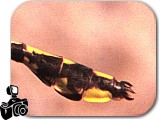 Medium
to large dragonflies, (4.3 – 8.3 cm BL), often with
an expanded tip (club), at the end of the abdomen. Their
eyes do not meet across the top of the head. Thirteen
(13) species are found here. Most Clubtails breed in flowing
waters, often in large streams or rivers. Adults tend
to perch on the ground. Medium
to large dragonflies, (4.3 – 8.3 cm BL), often with
an expanded tip (club), at the end of the abdomen. Their
eyes do not meet across the top of the head. Thirteen
(13) species are found here. Most Clubtails breed in flowing
waters, often in large streams or rivers. Adults tend
to perch on the ground. |
- Spiketails (Cordulegastridae)
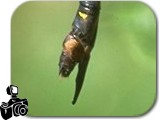 Large,
slender dragonflies (6 – 7.8 cm BL), usually black
and yellow in colour. Their eyes just meet on top of the
head. Females have a spike-like ovipositor at the tip
of the abdomen. Only one (1) species is found in Manitoba,
the Twin-spotted Spiketail (Cordulegaster maculatus).
Spiketails breed in small streams. Large,
slender dragonflies (6 – 7.8 cm BL), usually black
and yellow in colour. Their eyes just meet on top of the
head. Females have a spike-like ovipositor at the tip
of the abdomen. Only one (1) species is found in Manitoba,
the Twin-spotted Spiketail (Cordulegaster maculatus).
Spiketails breed in small streams. |
- Cruisers (Macromiidae)
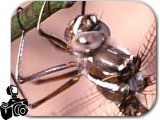 Large,
slender dragonflies (5.5 – 7 cm BL) with very long
legs. Their body colour is variable, but most have bright
green eyes. Two (2) species are found in Manitoba. Cruisers
breed in clear lakes and streams. Large,
slender dragonflies (5.5 – 7 cm BL) with very long
legs. Their body colour is variable, but most have bright
green eyes. Two (2) species are found in Manitoba. Cruisers
breed in clear lakes and streams. |
- Emeralds (Cordulidae)
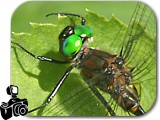 Small
to medium dragonflies (4 – 6.3 cm BL), with bright
green eyes and dark bodies with a metallic sheen. There
are 18 species in Manitoba. Emeralds breed in forested
lakes, ponds and bogs. Small
to medium dragonflies (4 – 6.3 cm BL), with bright
green eyes and dark bodies with a metallic sheen. There
are 18 species in Manitoba. Emeralds breed in forested
lakes, ponds and bogs. |
- Skimmers (Libellulidae)
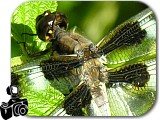 Small
to medium, stoutly built dragonflies (2.5 – 5 cm
BL). There are 24 species here. Skimmers show great variation
in colouration and markings. They breed in ponds and still
waters. Small
to medium, stoutly built dragonflies (2.5 – 5 cm
BL). There are 24 species here. Skimmers show great variation
in colouration and markings. They breed in ponds and still
waters. |
|

Fly back to NatureNorth.com |